Butternut, goat’s cheese and rosemary tatin
Serve with a crisp green salad in a lemony dressing. Serves eight as a starter, four as a main course.
1 small butternut squash, peeled, ends trimmed
1 tbsp olive oil
1 tsp finely chopped rosemary leaves, plus 1 whole sprig
2 garlic cloves, peeled and crushed
Salt and freshly ground black pepper
45g caster sugar
150g goat’s cheese log (with rind), cut into 1cm-thick discs
350g ready-rolled all-butter puff pastry
Heat the oven to 180C/350F/gas mark 4. Cut the squash in half lengthways, scoop out and discard the seeds, then cut the flesh into 0.5-1cm half-moons and put these in a medium bowl; you should have about 500g in total. Add the oil, chopped rosemary, garlic, half a teaspoon of salt and plenty of pepper, and toss to coat.
Heat a 24cm nonstick, oven-proof frying pan on a medium-high flame. Add the sugar, cook for four to five minutes, until it melts and becomes a semi-dark caramel, then take off the heat (it will keep cooking, so don’t leave it too long). Leave the caramel to cool a little, then lay the sprig of rosemary in its centre. Arrange the squash slices around the rosemary in a circular pattern, working from the outside in and overlapping as much as possible. Dot cheese here and there (you want some underneath the squash, some in between and some on top), and spoon over any rosemary and garlic left in the bowl.
Cut the pastry into a rough 26cm circle and lay it on top of the squash, making sure it covers everything (if need be, use the offcuts to patch up any gaps). Prick all over with a fork and bake for 50 minutes, until the pastry is golden brown and the caramel is bubbling up at the edges. Put a large plate upside down on top of the frying pan, and invert so the tart comes out on to the plate (make sure to protect your hands from the scalding caramel). The squash will now be on top of the tart. If any pieces of squash stick to the pan, just lift them out and put them back in place on the finished tart. Serve warm.
Curried fish with leeks and peas
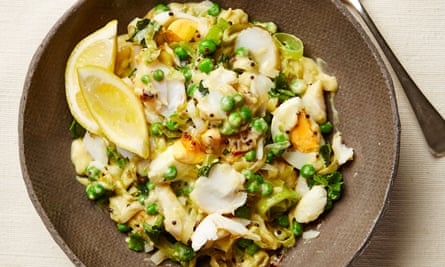
Pure comfort food, whether you serve it as it is, with a baked potato on the side or topped with mashed potato to turn it into a special fish pie. (If you go for that last option, bake two potatoes, and mash the flesh with butter and milk; tip the fish mix into an ovenproof dish, spread with the mash and bake in a hot oven until crisp on top.) Serves four to six.
500ml whole milk
40g coriander, stalks and leaves separated
2 tsp medium curry powder
3 lemons: shave the zest of 1 into fine strips, finely grate the zest of another and cut the third into wedges, to serve
3 large leeks, finely sliced – keep the white and green parts separate
Salt and black pepper
450g smoked cod fillet, skinned
60g unsalted butter
2 tbsp plain flour
2 tsp black mustard seeds
200g frozen peas
4 eggs, hard-boiled, peeled and quartered
Pour the milk into a large saute pan for which you have a lid, and add the coriander stalks, curry powder, all the lemon zest, the green part of the leeks and a quarter-teaspoon of salt. Bring to a simmer on a medium heat, cook for 10 minutes, then add the fish, cover and poach for five minutes. Using a slotted spoon, transfer the fish to a plate, then flake. Strain the milk into a bowl.
Put half the butter in a medium saucepan with the flour, a third of a teaspoon of salt and plenty of pepper. On a medium heat, stir until the butter melts and the mixture thickens, then slowly pour in the infused milk and cook, still stirring constantly, for three minutes, until the sauce is thick and smooth. Take the bechamel off the heat.
Melt the remaining butter in the same saute pan on a medium-high heat, then fry the white part of the leeks for eight minutes, stirring frequently, until soft and starting to brown. Add the mustard seeds and frozen peas, stir through for two to three minutes, then add the flaked fish, coriander leaves, bechamel and eggs. Stir gently, just to combine, and serve with lemon wedges alongside.
Charred prawn, sweetcorn and tomato salad

Shelling prawns is a fiddly job, so by all means use peeled ones if you prefer; that said, they won’t have intact tails, which look much better on the plate. Serves four as a starter or two as a main course.
440g shell-on tiger prawns, peeled (leave the tails intact) and deveined (or 240g peeled tiger prawns)
1 tsp olive oil
Salt
1 small red onion, peeled and cut into 1.5cm-wide wedges
100g frozen sweetcorn, defrosted
250g cherry tomatoes
1 tbsp picked marjoram (or oregano)
For the ginger, lime and sriracha dressing
2cm piece fresh ginger, peeled and finely chopped
1 tbsp sriracha
1½ tbsp olive oil
Finely grated zest of 1 lime (1 tsp), plus 1½ tbsp lime juice
¼ tsp caster sugar
In a small bowl, mix the dressing ingredients and an eighth of a teaspoon of salt.
Put a char-grill on a high flame and ventilate the kitchen. While it’s heating up, mix the prawns with the olive oil and an eighth of a teaspoon of salt. Griddle the onion wedges for five minutes, turning them every so often, until charred and cooked, but still with some bite. Transfer to a large bowl, then grill the corn for two minutes, until charred. Add to the onion bowl, then grill the tomatoes for three minutes, turning regularly, so they’re charred all over, and add to the bowl. Griddle the prawns for four minutes, turning them halfway, until charred and cooked through. Add to the bowl with the marjoram and dressing, toss gently, and serve at once.
Beef ragout with semolina and parmesan porridge
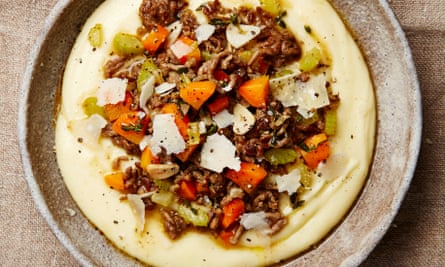
Calling any dish an easy midweek supper is a cliche, I know, but that’s exactly what this is; it’s also delicious. You can serve the ragout without the porridge, if you prefer, or with spaghetti, rice or potatoes. If you are making the porridge, and want to get ahead, bear in mind that it will carry on thickening off the heat, so check the consistency before serving: you may need to thin it with a little water. You can also make the ragout ahead of time – just gently reheat. Serves four generously.
45ml olive oil
500g beef mince
Salt and black pepper
1 onion, peeled and roughly chopped
3 sticks celery, roughly chopped
2 carrots, peeled and roughly chopped
3 cloves garlic, peeled and thinly sliced
2 tbsp picked thyme leaves
60ml dry white wine
75ml stock (beef, chicken or vegetable)
For the semolina porridge
600ml whole milk
600ml water
180g semolina
130g parmesan, finely shaved
Heat two tablespoons of oil in a large saute pan on a medium-high flame, then add the mince, three-quarters of a teaspoon of salt and plenty of pepper. Fry for 10 minutes, stirring frequently to break up the mince, until it’s dark golden brown and starting to go crisp. Add the onion, celery, carrots, garlic and thyme and fry for 10 minutes, stirring often, until the vegetables are cooked but still have some bite. Add the wine, cook for a minute until the liquid has evaporated, then add the stock, stir for 30 seconds and take off the heat.
For the porridge, pour the milk and water into a medium saucepan on a medium-high heat. Bring to a simmer, turn down the heat to medium, then add the semolina, three-quarters of a teaspoon of salt and plenty of pepper. Whisk continuously for three to four minutes, until the mixture is smooth and thick, then stir in 100g parmesan and a tablespoon of oil. Divide the porridge between four shallow bowls, top with a generous helping of hot ragout and serve with the remaining parmesan sprinkled over the top.
Lamb and feta meatballs
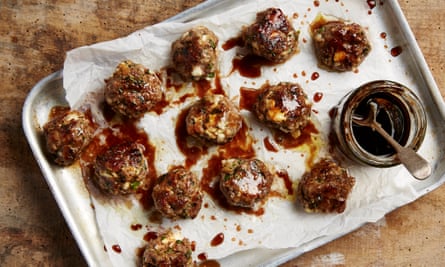
Serve as a snack or starter, or bulk it up into a main course with some creamy mashed potatoes and steamed vegetables alongside. The pomegranate molasses are a wonderful addition, but if you don’t have any, the dish will work fine without. Serves six as a starter or snack.
500g minced lamb
100g feta, crumbled into roughly
1cm pieces
2 tbsp picked thyme leaves
2 garlic cloves, peeled and crushed
10g parsley leaves, finely chopped
1 slice white bread, blitzed
½ tsp ground cinnamon
Salt and black pepper
1 tbsp olive oil
2 tsp pomegranate molasses, plus 1 tbsp extra to serve (optional)
Heat the oven to 200C/390F/gas mark 6. Put all the ingredients apart from the oil and pomegranate molasses in a large bowl, add three-quarters of a teaspoon of salt and plenty of pepper, and mix with your hands to combine. Still using your hands, divide the meatball mix into 18 roughly 35g portions and form each into 4cm-wide balls.
Heat the oil in a large frying pan on a medium-high flame, then fry the meatballs (cook them in batches, if need be), for five to six minutes in total, gently turning them throughout, until golden brown all over. Transfer the meatballs to an oven tray lined with baking paper, drizzle pomegranate molasses over the top, if using, and bake for five minutes, to cook through.
Serve hot, with a final tablespoon of pomegranate molasses spooned on top.
Fresh tagliatelle in yoghurt with spring onion and chilli
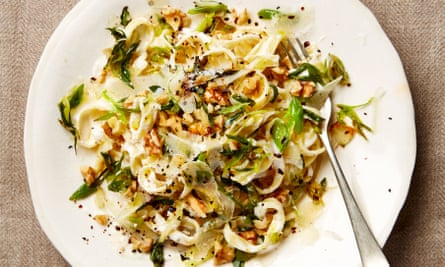
I love urfa chilli flakes: they have a big aroma and a mellow kick, so you can be liberal with them, while their deep red colour looks spectacular sprinkled on all sorts. (Ancho chilli flakes have a similar impact, and tend to be more widely available, so use those instead, if need be.) Serves six as a starter, four as a main course.
2 tbsp olive oil, plus 1 extra to serve
6 cloves garlic, peeled and sliced fine
20 spring onions, trimmed and cut on an angle into thin slices
250g greek yoghurt
250g sheep’s yoghurt
1 tbsp lemon juice
Salt
400g fresh tagliatelle
90g walnut halves, roughly chopped
60g pecorino, finely shaved
1 tbsp urfa chilli flakes
Heat two tablespoons of oil in a large saute pan on a medium-high flame, then fry the garlic and spring onion for six to seven minutes, until just starting to brown. Spoon into a bowl.
Tip both yoghurts, the lemon juice, 400ml water and half a teaspoon of salt into the pan (there’s no need to wipe it down first) and put on a medium heat. Warm through for three to four minutes, until the mixture just starts to steam (don’t cook it for any longer, or it will split). Add the pasta, toss to coat and leave to cook slowly for six to seven minutes, until the pasta is cooked and the sauce has thickened.
Divide the pasta between shallow bowls and spoon the garlic and spring onion on top. Sprinkle with walnuts, pecorino and chilli, drizzle over the final tablespoon of oil and serve.
Spiced duck breast with plum and ginger chutney
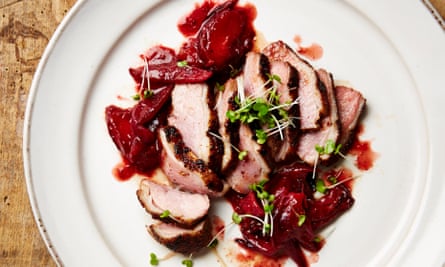
Taste the plums first: if they’re very sweet, you may want to reduce the sugar here. This goes very well with a green salad or some rice or potatoes. Serves four.
6 star anise, blitzed to a powder (or 2 tbsp ground star anise)
50g soft dark brown sugar
Flaked sea salt and black pepper
4 duck breasts, skin scored 3mm deep on the diagonal in a crosshatch
1 tbsp sunflower oil
2 red onions, peeled and cut into 1cm-wide wedges
4cm piece fresh ginger, peeled and finely grated
4 plums, cut into 1.5-2cm wedges
1½ tbsp red-wine vinegar
1 tbsp Dijon mustard
10g cress, to serve
Mix two-thirds of the star anise in a small bowl with 15g sugar, a teaspoon and a half of salt and lots of pepper. Rub all over the duck and refrigerate for at least an hour.
Heat the oil in a medium frying pan on a medium-high flame, then fry the onions for 10-12 minutes, stirring, until caramelised and soft. Add the ginger, plums, remaining star anise and a teaspoon of salt, stir for a minute, then add the vinegar, mustard and remaining sugar. Turn the heat to medium-low and cook for 10 minutes, until the fruit is soft and the sauce thick. Take off the heat.
Heat the oven to 220C/425F/gas mark 7. Lay the duck skin side down in a large oven-proof frying pan on a medium-high heat. Fry for five to six minutes, until the skin is caramelised and crisp, then turn and fry for another minute (you won’t need any oil, because of the fat in the duck). Transfer the pan to the hot oven (if the duck releases lots of fat, pour some off first and save it for the next time you roast potatoes) and roast for five minutes (for medium-rare); if you prefer duck a little more done, roast for a few minutes more. Leave to rest for five minutes, then cut each breast widthways into 7mm-thick slices.
While the duck is roasting and resting, gently warm through the chutney, then add any of the juices released when the duck is sliced, to thin it a little. Divide the duck between four plates, spoon the chutney alongside and serve, with cress sprinkled on top.
Chicken with miso, ginger and lime

This is lovely served warm from the oven, in which case I’d be tempted to have some sticky or basmati rice alongside, or at room temperature. You can make it a day ahead, in which case keep it in the fridge overnight and take it out half an hour before serving, so it’s not too cold. Serves six.
6 chicken legs, skin scored a few times
2 tsp sunflower oil
Salt
2 tbsp mirin
2 tbsp maple syrup
2 tbsp soy sauce
50g white miso
30g ginger, peeled and finely grated
2 garlic cloves, peeled and crushed
1 lime, juiced, zest cut off thin strips
40g coriander stems, chopped into 6cm-long pieces
2 red chillies, trimmed and cut in half lengthways
8 spring onions, trimmed and cut in half lengthways
Heat the oven to 200C/390F/gas mark 6. Put the chicken in a large bowl with the oil and half a teaspoon of salt, mix together to coat and set aside.
Heat a large frying pan on a medium-high flame, then sear the chicken legs on one side for three to four minutes, until the skin turns golden brown, then turn over, cook for another three to four minutes and transfer to a clean bowl.
Put the mirin, maple syrup, soy, miso, ginger, garlic, lime zest and juice in a large bowl. Whisk to combine, then add the chicken and stir to coat. Tip the chicken into a high-sided, 25cm x 30cm baking dish, cover tightly with foil and bake for 20 minutes. Remove the foil and, using tongs, raise each chicken leg one by one and put some coriander stems, chillies and spring onion underneath, returning each leg to the pan cooked side down. Bake the chicken uncovered for another 30 minutes, turning the legs again halfway through and basting a couple of times. The chicken will by now be golden brown, sticky and tender, and the chillies and spring onions will be soft.
To serve, put a chicken leg on each plate, surround it with the coriander, chilli and spring onion mix, and drizzle over the sauce.

Comments (…)
Sign in or create your Guardian account to join the discussion